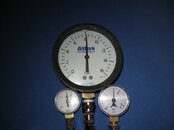Zung
Contributor
I've got 3 and they are fairly consistent: left, CL 2.5: $30 @ dive shop, center, CL 1: $2 @ eBay, right, unspecified: $10 @ hardware store. CL is the nominal precision.
The big one is slow, possibly because it's filled with liquid, or maybe because of the bigger Bourdon tube inside. Its response time is actually slower than the time it takes a decent 1st stage to recover after a purge, so it may hide some problems.

The big one is slow, possibly because it's filled with liquid, or maybe because of the bigger Bourdon tube inside. Its response time is actually slower than the time it takes a decent 1st stage to recover after a purge, so it may hide some problems.

Last edited:



